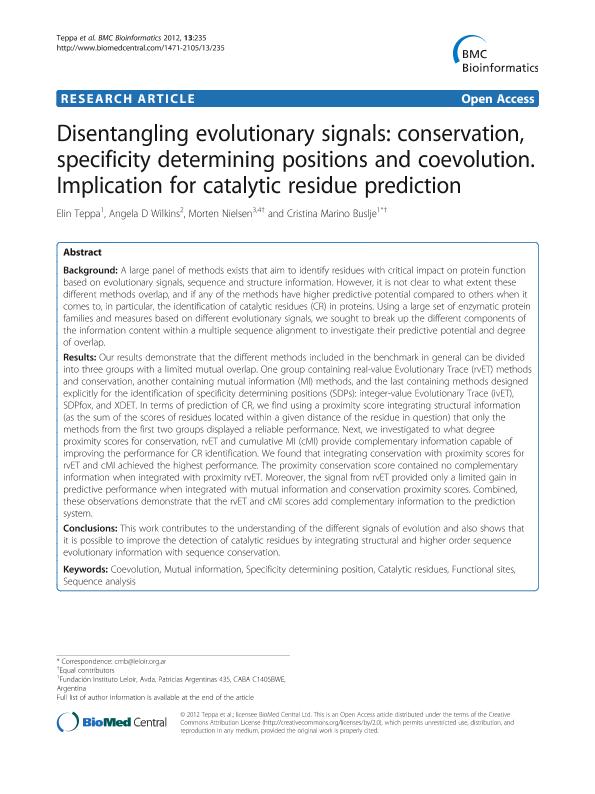Mostrar el registro sencillo del ítem
dc.contributor.author
Teppa, Roxana Elin

dc.contributor.author
Wilkins, Angela D.
dc.contributor.author
Nielsen, Morten

dc.contributor.author
Marino Buslje, Cristina

dc.date.available
2020-03-26T18:55:25Z
dc.date.issued
2012-09
dc.identifier.citation
Teppa, Roxana Elin; Wilkins, Angela D.; Nielsen, Morten; Marino Buslje, Cristina; Disentangling evolutionary signals: conservation, specificity determining positions and coevolution. Implication for catalytic residue prediction; BioMed Central; BMC Bioinformatics; 13; 1; 9-2012; 1-8
dc.identifier.issn
1471-2105
dc.identifier.uri
http://hdl.handle.net/11336/100979
dc.description.abstract
Background: A large panel of methods exists that aim to identify residues with critical impact on protein function based on evolutionary signals, sequence and structure information. However, it is not clear to what extent these different methods overlap, and if any of the methods have higher predictive potential compared to others when it comes to, in particular, the identification of catalytic residues (CR) in proteins. Using a large set of enzymatic protein families and measures based on different evolutionary signals, we sought to break up the different components of the information content within a multiple sequence alignment to investigate their predictive potential and degree of overlap.Results: Our results demonstrate that the different methods included in the benchmark in general can be divided into three groups with a limited mutual overlap. One group containing real-value Evolutionary Trace (rvET) methods and conservation, another containing mutual information (MI) methods, and the last containing methods designed explicitly for the identification of specificity determining positions (SDPs): integer-value Evolutionary Trace (ivET), SDPfox, and XDET. In terms of prediction of CR, we find using a proximity score integrating structural information (as the sum of the scores of residues located within a given distance of the residue in question) that only the methods from the first two groups displayed a reliable performance. Next, we investigated to what degree proximity scores for conservation, rvET and cumulative MI (cMI) provide complementary information capable of improving the performance for CR identification. We found that integrating conservation with proximity scores for rvET and cMI achieved the highest performance. The proximity conservation score contained no complementary information when integrated with proximity rvET. Moreover, the signal from rvET provided only a limited gain in predictive performance when integrated with mutual information and conservation proximity scores. Combined, these observations demonstrate that the rvET and cMI scores add complementary information to the prediction system.Conclusions: This work contributes to the understanding of the different signals of evolution and also shows that it is possible to improve the detection of catalytic residues by integrating structural and higher order sequence evolutionary information with sequence conservation. © 2012 Teppa et al.; licensee BioMed Central Ltd.
dc.format
application/pdf
dc.language.iso
eng
dc.publisher
BioMed Central

dc.rights
info:eu-repo/semantics/openAccess
dc.rights.uri
https://creativecommons.org/licenses/by-nc-sa/2.5/ar/
dc.subject
CATALYTIC RESIDUES
dc.subject
COEVOLUTION
dc.subject
FUNCTIONAL SITES
dc.subject
MUTUAL INFORMATION
dc.subject
SEQUENCE ANALYSIS
dc.subject
SPECIFICITY DETERMINING POSITION
dc.subject.classification
Otras Ciencias Biológicas

dc.subject.classification
Ciencias Biológicas

dc.subject.classification
CIENCIAS NATURALES Y EXACTAS

dc.title
Disentangling evolutionary signals: conservation, specificity determining positions and coevolution. Implication for catalytic residue prediction
dc.type
info:eu-repo/semantics/article
dc.type
info:ar-repo/semantics/artículo
dc.type
info:eu-repo/semantics/publishedVersion
dc.date.updated
2020-02-07T13:39:36Z
dc.identifier.eissn
1471-2105
dc.journal.volume
13
dc.journal.number
1
dc.journal.pagination
1-8
dc.journal.pais
Reino Unido

dc.journal.ciudad
Londres
dc.description.fil
Fil: Teppa, Roxana Elin. Consejo Nacional de Investigaciones Científicas y Técnicas; Argentina. Fundación Instituto Leloir; Argentina
dc.description.fil
Fil: Wilkins, Angela D.. Baylor College of Medicine. Department of Molecular and Human Genetics; Estados Unidos
dc.description.fil
Fil: Nielsen, Morten. Consejo Nacional de Investigaciones Científicas y Técnicas. Centro Científico Tecnológico Conicet - La Plata. Instituto de Investigaciones Biotecnológicas. Universidad Nacional de San Martín. Instituto de Investigaciones Biotecnológicas; Argentina. Technical University of Denmark; Dinamarca
dc.description.fil
Fil: Marino Buslje, Cristina. Fundación Instituto Leloir; Argentina
dc.journal.title
BMC Bioinformatics

dc.relation.alternativeid
info:eu-repo/semantics/altIdentifier/url/http://www.biomedcentral.com/1471-2105/13/235
dc.relation.alternativeid
info:eu-repo/semantics/altIdentifier/doi/http://dx.doi.org/10.1186/1471-2105-13-235
Archivos asociados
